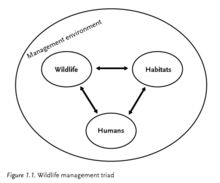The examples and perspective in this article deal primarily with the United States and the United Kingdom and do not represent a worldwide view of the subject. (January 2023) |
Wildlife management is the management process influencing interactions among and between wildlife, its habitats and people to achieve predefined impacts.[1][2][3] It attempts to balance the needs of wildlife with the needs of people using the best available science. Wildlife management can include wildlife conservation, population control, gamekeeping, wildlife contraceptive and pest control.[4]

Wildlife management aims to halt the loss in the Earth's biodiversity,[5][6] by taking into consideration ecological principles such as carrying capacity, disturbance and succession, and environmental conditions such as physical geography, pedology and hydrology.[7][8][9][10] Most wildlife biologists are concerned with the conservation and improvement of habitats; although rewilding is increasingly being undertaken.[11] Techniques can include reforestation, pest control, nitrification and denitrification, irrigation, coppicing and hedge laying.
Gamekeeping is the management or control of wildlife for the well-being of game and may include the killing of other animals which share the same niche or predators to maintain a high population of more profitable species, such as pheasants introduced into woodland. Aldo Leopold defined wildlife management in 1933 as the art of making land produce sustained annual crops of wild game for recreational use.[12]
- ^ Decker, Daniel J.; Riley, Shawn J. (Shawn James); Siemer, William F. (2012). Human dimensions of wildlife management (2nd ed.). Baltimore: Johns Hopkins University Press. p. 4. ISBN 978-1-4214-0654-1. OCLC 778244877.
- ^ Sinclair, Anthony R. E.; Fryxell, John M.; Caughley, Graeme (2006). Wildlife ecology, conservation, and management (2nd ed.). Malden, MA: Blackwell. p. 2. ISBN 978-1-4051-0737-2. OCLC 58526307.
- ^ Raj, A. J.; Lal, S. B. (2013). Forestry Principles and Applications. Jodhpur: Scientific Publishers (India). p. 359. ISBN 978-93-8623774-3. OCLC 972943172.
- ^ Potter, Dale R.; Kathryn M. Sharpe; John C. Hendee (1973). Human Behavior Aspects Of Fish And Wildlife Conservation - An Annotated Bibliography (PDF). U.S. Dept. of Agriculture. p. 290.
- ^ James, Frances C. (1980-07-11). "Ecological Recommendations: Conservation Biology. An Evolutionary-Ecological Perspective". Science. 209 (4453): 267–268. doi:10.1126/science.209.4453.267.b. ISSN 0036-8075.
- ^ Soulé, Michael E. (1985-12-01). "What is Conservation Biology?: A new synthetic discipline addresses the dynamics and problems of perturbed species, communities, and ecosystems". BioScience. 35 (11): 727–734. doi:10.2307/1310054. ISSN 0006-3568.
- ^ Soule, Michael E. (1986). Conservation Biology: The Science of Scarcity and Diversity. Sinauer Associates. p. 584. ISBN 9780878937950.
- ^ Hunter, M. L. (1996). Fundamentals of Conservation Biology. Blackwell Science Inc., Cambridge, Massachusetts., ISBN 0-86542-371-7.
- ^ Groom, M.J., Meffe, G.K. and Carroll, C.R. (2006) Principles of Conservation Biology (3rd ed.). Sinauer Associates, Sunderland, MA. ISBN 0-87893-518-5
- ^ van Dyke, Fred (2008). Conservation Biology: Foundations, Concepts, Applications, 2nd ed. Springer Verlag. p. 478. ISBN 978-1-4020-6890-4.
- ^ Torres, Aurora; Fernández, Néstor; zu Ermgassen, Sophus; Helmer, Wouter; Revilla, Eloy; Saavedra, Deli; Perino, Andrea; Mimet, Anne; Rey-Benayas, José M.; Selva, Nuria; Schepers, Frans (2018-12-05). "Measuring rewilding progress". Philosophical Transactions of the Royal Society B: Biological Sciences. 373 (1761): 20170433. doi:10.1098/rstb.2017.0433. PMC 6231071. PMID 30348877.
- ^ Leopold, Aldo (1996). Game management. ISBN 81-85019-54-1. OCLC 971482354.